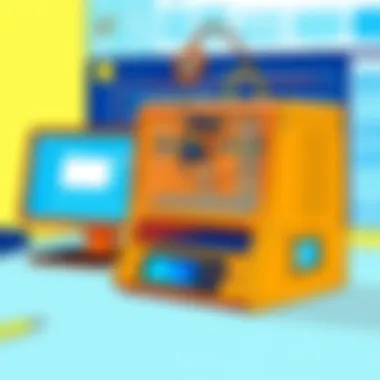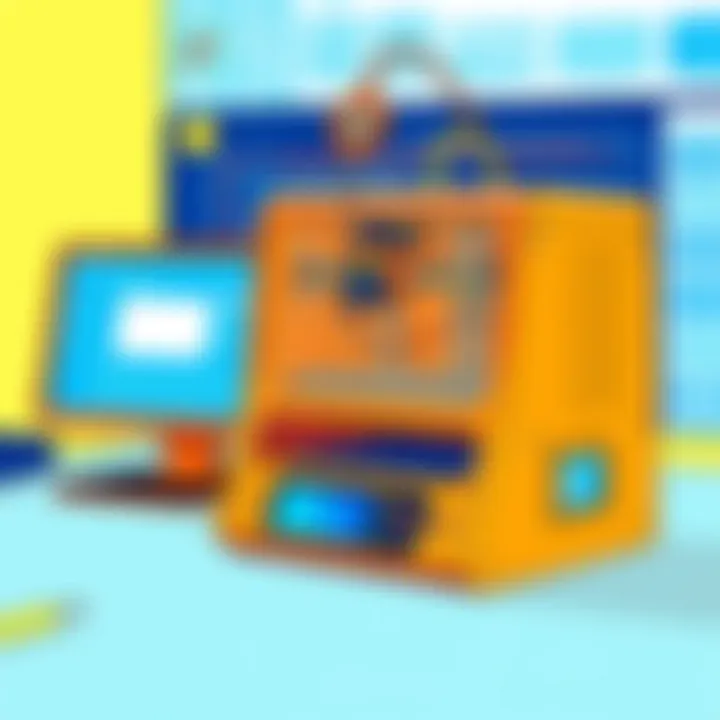Discovering the Value of the Prusa Mini Sale


Intro
The realm of 3D printing continues to evolve at breakneck speed, with new innovations and offerings emerging regularly. Amidst this whirlwind, the Prusa Mini Sale stands as a noteworthy event that catches the eye of both industry professionals and hobbyists alike. Understanding the significance of such sales can make a substantial difference in how one approaches their purchasing decisions. This article provides a thorough analysis of the Prusa Mini Sale, exploring crucial aspects that go beyond the surface.
In the following sections, we will dissect the hardware specifications and performance metrics of the Prusa Mini. Furthermore, we’ll take a closer look at the software features and user interface that elevate this printer’s standing in the market. By dissecting these components, we aim to offer a clearer perspective on how the Prusa Mini meets various printing needs and stands out among competitors.
As you delve into this exploration, our goal is to equip you with the insights necessary to navigate the 3D printing landscape more effectively, ensuring informed choices tailored to your unique printing aspirations.
Understanding the Prusa Mini
In the world of 3D printing, the Prusa Mini has carved out a niche for itself, appealing to both novices and seasoned users alike. This small-scale printer combines usability with robust performance, fluidizing the entry into the 3D printing realm. If you're interested in practical applications or just looking to print intricate designs, understanding the Prusa Mini's offerings is paramount to making an informed decision.
Overview of Specifications
Build volume
The Prusa Mini boasts a build volume of 180 x 180 x 180 mm, which, while not the largest in the market, serves as a sweet spot for hobbyists and educational institutions. This volume allows for sufficient flexibility, making it suitable for a variety of projects, from intricate miniatures to educational prototypes.
One notable feature is how this compact size aids in reducing material waste—an attractive attribute for both cost-conscious users and eco-friendly advocates. The sizeable print area strikes a balance, preventing users from feeling cramped while still keeping print times reasonable. However, potential buyers should weigh this against projects requiring more extensive space, as you might find your creativity suddenly limited.
Print resolution
When it comes to print resolution, the Prusa Mini impresses with a layer resolution that can go as fine as 50 microns. Such precision enhances details, especially in complex prints or artistic endeavors. The ability to produce intricate models is a strong selling point for those looking to create exceptional pieces.
While high resolution yields spectacular results, it's worth noting that it may also significantly increase print times. Users wanting a quicker output might find this trade-off something to consider before hitting print.
Materials compatibility
The Prusa Mini is compatible with a range of materials, including PLA, PETG, and ASA. This versatility ensures that users have the flexibility to choose their desired material based on their project’s needs, be it durability, aesthetics, or environmental considerations.
That said, while these common materials are relatively easy to work with, some might find limitations when exploring advanced filaments. If you're leaning towards specialty materials or exotic blends, keep in mind that you may need to tweak the setup or seek out modifications.
Performance Assessment
Print quality
As for print quality, the Prusa Mini stands out due to its reliable performance and consistent results. Users often rave about the quality, staying above the curve in comparison to other printers within its price range. Whether you're producing functional parts or creative models, the quality is generally one of its more appealing aspects.
Prusa's dedication to precision in manufacturing components aids significantly in maintaining high standards. However, some expert users might require fine-tuning from time to time to optimize output for specific projects—an aspect to ponder if you're considering a plug-and-play option.
Speed and efficiency
The printer's speed is a mixed bag, generally leaning towards satisfactory without being the fastest on the market. With speeds reaching up to 200 mm/s, it accommodates various needs well enough. However, like with many aspects, speed can come at the expense of quality, meaning users should find a happy balance depending on the project at hand.
Efficiency takes another turn when you factor in energy consumption, which is relatively low for the Prusa Mini. For the environmentally conscious user, this model is a lenient choice, while still delivering adequate performance.
Ease of use
A significant draw of the Prusa Mini is its user-friendly interface, making it quite approachable for beginners. Setting up the device requires relatively few technical skills, and the knowledge base available provides an excellent starting point for novices. The intuitive control panel simplifies the entire process, allowing users to manage settings without feeling overwhelmed.
Yet, it’s crucial to bear in mind that as straightforward as it is, some complexities still exist. Users who delve into advanced settings may encounter a learning curve. For those who are not intimidated by a little tinkering, however, it could open the door to mastering 3D printing.
The Prusa Mini is not just a printer; it’s a gateway to a universe of creativity, merging ease of use with the technical potential for customization.
Market Context for 3D Printers
Understanding the market context for 3D printers serves as an essential frame of reference when discussing the Prusa Mini Sale. The importance of this segment lies in how it outlines the landscape in which the Prusa Mini operates, revealing the undercurrents that customers must navigate. Making sense of this environment provides not only insights into the Prusa Mini’s competitive edge but also underscores broader market dynamics that ultimately affect pricing and user engagement strategies.
Current Trends in 3D Printing
Emerging technologies
In the world of 3D printing, emerging technologies play a pivotal role in defining market viability and innovation. The evolution of materials science has given rise to filaments that are more versatile and sustainable, such as bioplastics and composite materials. These advancements enhance the quality and performance of printed objects, making it easier for users to create complex designs.
Key characteristics of these technologies emphasize adaptability. For instance, advancements in multi-material printing allow creators to combine various substances in a single print, thus broadening the spectrum of what can be achieved. This aspect is particularly beneficial for industries that require functional prototypes or specialized components.
However, integrating new technologies could lead to challenges as well, such as increased learning curves and machine upkeep that some users might find daunting, especially in the context of the Prusa Mini. The complexity of adopting a new system can be a hurdle that isn’t always acknowledged upfront.
Consumer demand shifts
Consumer behavior in the 3D printing market signals a notable shift towards personalization and accessibility. This transformation is a responding wave to the growing desire for customization across various sectors—from hobbyists to small businesses looking for unique solutions. For example, the rise of on-demand printing services makes it easy for consumers to procure bespoke items without investment into their own machinery.
This trend underscores a key characteristic: availability. Such a shift signifies that manufacturers, including Prusa, must remain attuned to consumer preferences for individuality and bespoke solutions. One notable advantage here is the ability to attract a more diversified customer base, spanning from casual users to conscientious entrepreneurs.
However, the downside could be the over-saturation of options, making it increasingly difficult for companies to distinguish themselves in a crowded marketplace.
Industry applications
The versatility of 3D printing technologies means they are being increasingly adopted in various industries—healthcare, automotive, and even construction are witnessing significant innovations fueled by 3D printing. For instance, the capability to quickly produce functional prosthetics or prototypes can expedite product development cycles, driving efficiencies in resource allocation.
Key characteristics of industry applications showcase collaboration between sectors. The cross-disciplinary nature of 3D printing is becoming a common thread that triggers enhanced innovation. However, each industry faces unique challenges regarding regulatory standards and material specifications which can complicate integration.
Educating workforce members on how to utilize these technologies effectively becomes crucial to unlocking the full potential. The Prusa Mini's reputation for user-friendliness places it as a solid contender in this evolving landscape.
Positioning of Prusa in the Market
Brand reputation
Prusa is not merely another name in the 3D printing arena; it's a brand that has cultivated a reputation founded on quality and community engagement. One specific aspect that enhances brand strength is the emphasis on customer feedback; the company actively adjusts its offerings based on user experiences, fostering loyalty among its clientele.
The key characteristic here is trust, as established via consistent product performance and a robust online community. Consumers feel more secure purchasing from a brand that not only delivers upon its promises but continually seeks improvement in response to user input.


That said, high expectations can be a double-edged sword. While many users may trust in the brand’s prowess, managing that trust requires ongoing innovation and communication.
Competitive analysis
In an immensely competitive marketplace, understanding how Prusa positions itself against rivals reveals vital insights into its strategies. The focus here is on both performance metrics and pricing structures relative to other brands, such as Creality and Anycubic. Surprisingly, some users cite Prusa’s software as a distinct advantage, enhancing the overall usability of its products.
The key characteristic is that Prusa’s open-source philosophy sets it apart—it allows users to customize their experience more than with competitors who may offer locked systems. This fundamental differentiation can be highly beneficial in attracting tech-savvy individuals keen on tailoring their setups.
However, the competitive landscape is fluid, and Prusa must continually evolve to retain its edge against newcomers looking to capture market share.
User satisfaction surveys
User satisfaction surveys are a yardstick for understanding how well a product meets or exceeds expectations. The feedback from these questionnaires often highlights installation ease, reliability, and community support as positive attributes associated with the Prusa Mini. Regular engagement through customer surveys enables Prusa to pinpoint areas of improvement, solidifying their presence in the marketplace.
One unique feature worth noting is that Prusa often publishes results from its user satisfaction surveys, enhancing credibility. Trustworthiness here aligns closely with transparency, allowing potential buyers to gauge how the product performs in real-world scenarios. The inversion here, though, is that negative feedback can create scrutiny that requires a prompt and effective response.
Furthermore, the push for feedback provides users an avenue to contribute to product enhancement, providing a sense of ownership in the community.
Analysis of the Prusa Mini Sale
The Prusa Mini Sale serves as a pivotal point for both consumers and the ever-evolving landscape of 3D printing technology. Analyzing this sale goes beyond merely understanding price reductions; it unveils trends, motivations, and market conditions that reflect on the consumer’s purchasing power. Such sales play a critical role in shaping consumer perceptions and can offer洞 insights into what drives purchase decisions.
Motivations Behind the Sale
Understanding why a sale is occurring can provide crucial insight into its significance. The motivations behind the Prusa Mini Sale are multi-faceted, each contributing to the broader narrative of market dynamics.
Sales strategies
Sales strategies are the gears that keep the engines of promotions running smoothly. The Prusa Mini Sale utilizes strategies that encourage buyers to make swift decisions, like limited-time offers or bundled deals. This urgency often nudges would-be buyers into action.
A key characteristic of these strategies is the psychological trigger of fear of missing out (FOMO); it’s human nature to feel pressured when faced with scarcity. This aspect is particularly effective during sales events.
However, the flip side can sometimes see consumers experiencing buyer's remorse if they feel rushed into a decision that wasn't well thought out. That's where the balance comes in. It’s imperative to weigh the benefits against the potential drawbacks carefully.
Market saturation
Market saturation has a significant role in the unfolding of the Prusa Mini Sale. As more players enter the 3D printer arena, the sales become a game of survival for brands like Prusa.
The key characteristic of market saturation is competition; there are more options than ever, which can make customers second-guess their choices. While this creates opportunities for price reduction during a sale, it can also dilute brand loyalty. Thus, engaging discounts become not only appealing but necessary to capture consumer interest.
On one hand, this scenario allows customers to benefit from lower prices. On the other, it might create a perception that products—like the 3D printers—might be inferior due to the aggressive discounting.
Consumer engagement tactics
Consumer engagement tactics indeed add another layer to the motivations behind the Prusa Mini Sale. These tactics often include community discussions, social media campaigns, and online tutorials that bring customers into the fold. Incorporating these interaction points, particularly in the 3D printing community, fosters a sense of brand connection.
A prominent aspect is how these engagements amplify the sale's reach; word-of-mouth often carries more weight than conventional advertising. However, a pitfall could be the potential for negative feedback to spread just as quickly if the consumer feels misled or unsatisfied post-purchase.
Impact on Pricing
The effects of the Prusa Mini Sale ripple through its pricing structure, presenting a multifaceted scenario that warrants close examination.
Discount trends
Discount trends are a crucial part of understanding the sale's broader impact on pricing. The Prusa Mini Sale often provides deep discounts that reflect both immediate consumer needs and long-term pricing adjustments.
One characteristic is the seasonal nature of discounts; they are not just random but usually timed to coincide with specific consumer habits, such as back-to-school or holiday shopping. This planning makes it a wise choice for maximizing inventory turnover.
While customers might revel in the benefits of these discounts, the drawbacks may include the perception that the original pricing might have been inflated.
Comparative pricing studies
Comparative pricing studies shine a light on how Prusa stacks up against competitors during the sale. By examining other brands and their pricing strategies, potential buyers gain perspective on whether they are receiving a compelling offer.
One standout characteristic is the alignment of features with pricing; customers are often looking for value for money, not just the cheapest option available. This context allows for a measured view on the Prusa Mini's worth.
However, it can become a double-edged sword; while comparative studies offer clarity, they can also lead consumers down a rabbit hole of excessive research, delaying their decision.
Long-term price effects
Considering long-term price effects is paramount for buyers eyeing the Prusa Mini Sale. Understanding how present pricing can shape future price expectations gives consumers an edge in their purchasing decisions.
A significant characteristic is the trend of depreciating value over time; a lower initial purchase price could potentially translate into long-term savings. This foresight becomes a beneficial factor for financially savvy customers.
Nevertheless, the downside could be fluctuating market conditions that lead to unexpected price adjustments in either direction, creating uncertainty amidst confidence.
In summary, analyzing the Prusa Mini Sale not only highlights immediate benefits but sets the stage for longer-term financial considerations that resonate within the consumer landscape.
Consumer Considerations
When diving into the world of 3D printing and specifically the Prusa Mini, understanding consumer considerations is crucial. This section unpacks the various factors that potential buyers must weigh before making a purchase. It consists of identifying different types of users and assessing the long-term value of the investment.
Identifying Target Users
Hobbyists vs. Professionals
Hobbyists and professionals make up the core user base for the Prusa Mini. Hobbyists often dabble in 3D printing out of pure passion, wanting to create models and prototypes for personal use or marveling at the technical aspects of the printer. The key characteristic here is their experimental spirit and willingness to learn through trial and error. This enthusiasm often leads them to discover innovative designs and printing techniques.
In contrast, professionals lean on consistency and accuracy. Their work often requires precision for prototypes, detailed models, or even parts for production. The Prusa Mini satisfies both groups, but the inclination of hobbyists to push boundaries makes them a particularly vibrant segment of users, while professionals benefit from the reliability and print quality for their business needs.
Educational Institutions


Educational institutions are increasingly integrating 3D printing into their curriculums. Schools and universities see the Prusa Mini as a stepping stone for developing digital fabrication skills. The unique feature here is the blend of technology and creativity, allowing both teachers and students to explore engineering, design, and art.
This approach encourages innovation, making the Prusa Mini a popular choice in classrooms. That said, the initial cost and the complexity of setups can be a hurdle. Institutions must consider long-term maintenance and the potential need for teacher training, weighing the benefits against these challenges.
Small Businesses
Small businesses often seek to harness 3D printing as a way to prototype or produce custom parts efficiently. The Prusa Mini offers an accessible entry into this realm, with its user-friendly interface and consistent print performance. This makes it a beneficial choice for startups looking to minimize costs while maintaining product quality.
However, small businesses must continually assess their production demands and whether the Mini can keep up as needs evolve. Customization capabilities and downtime for maintenance can be factors that determine if the Prusa Mini will serve a small business well in the long term, ultimately influencing purchasing decisions.
Assessing Long-term Value
Total Cost of Ownership
The total cost of ownership goes far beyond the initial price tag. This encompasses consumables such as filament, maintenance, and potential repairs. Buyers must evaluate how often they will use the Prusa Mini and the types of prints they want to produce. Understanding this cost provides clarity on whether the investment is justifiable.
In many cases, the long-lasting quality of Prusa products warrants a slightly higher upfront cost since they often have a lower total cost of ownership over time.
Maintenance and Support
One of the paramount aspects that consumers should consider is maintenance and support. Prusa has a reputation for excellent customer service and active community forums, which can be a lifeline for new users. The ease of accessing support can mitigate issues that arise, offering peace of mind for buyers.
However, potential buyers should still be aware of the need for occasional part replacements or upgrades, which could add to their costs. Being prepared for these scenarios can be vital to ensuring an efficient working relationship with the printer.
Upgrade Potential
For those thinking ahead, the Prusa Mini holds the advantage of upgrade potential. As users become more experienced, they may look to expand their capabilities. The Mini can be upgraded with more advanced components or modified to support a wider range of materials. This flexibility can extend the life of the printer while keeping pace with evolving user needs.
Nevertheless, it is essential to gauge whether pursuing upgrades will align with a buyer’s specific goals. The allure of technology can also lead to unnecessary expenses if not thoughtfully evaluated.
Ultimately, being aware of these consumer considerations lays a solid foundation for informed decision-making when investing in the Prusa Mini.
Practical Buying Strategies
Making an informed choice when buying a 3D printer, particularly during a sale like the one for the Prusa Mini, requires more than just an impulse click on the ‘buy now’ button. Practical buying strategies come into play to ensure that potential buyers select options that best fit their needs and budget. This section will delve into several key strategies that can empower consumers.
Choosing the Right Package
Starter kits vs. standalone units
When diving into the world of 3D printing, many find themselves pondering whether to opt for a starter kit or a standalone unit. Starter kits usually include not only the printer but a bag of essential supplies such as filaments, tools, and sometimes even introductory guides. This bundled approach is particularly beneficial for newcomers who have little to no experience in setting up and troubleshooting their machines. Especially during sales, the savings on these kits can effectively enhance a buyer's experience, reducing the barrier to entry.
On the other hand, standalone units tend to offer flexibility. If one is already familiar with 3D printing, they might prefer to pick their own accessories and supplies tailored to their specific needs. However, this choice may become a slippery slope if they miss out on essential items that may add to their overall cost. In summary, starter kits provide a smooth launchpad while standalone units offer extensive freedom in customization; it really depends on where you find yourself in your 3D printing journey.
Accessories and add-ons
Accessories and add-ons are crucial when it comes to enhancing the functionality and versatility of the Prusa Mini. Things like upgraded nozzles, enhanced cooling systems, or specialized filaments can take your printing to the next level. The real beauty of these accessories is their ability to cater to specific needs or projects. A hobbyist may find a lot of value in flexible filament options, while more professional uses could require additional tooling or advanced material composites.
However, purchasing accessories must be done judiciously. While they can significantly improve print quality and efficiency, any buyer should weigh the costs against their expected outcomes. Accumulating unnecessary gear can quickly turn into an additional expense without a clear return on investment. Therefore, it’s wise to evaluate which add-ons genuinely align with your long-term 3D printing goals.
Warranty considerations
Warranties play a vital role in any purchase decision. They serve as safety nets, especially when buying technological equipment like the Prusa Mini. A manufacturer’s warranty can provide you with peace of mind, knowing that should anything go awry, you have backup. Major points to consider include the warranty duration, what is covered, and how hassle-free the service process is when making a claim.
It's worthwhile to compare warranties when purchasing from various channels, as some vendors may offer additional coverage. Also, a good warranty often reflects the manufacturer’s confidence in their product quality. For both new and seasoned users, weighing the warranty options can become a decisive factor in ensuring the longevity and reliability of your purchase.
Navigating Sale Channels
Official vendor vs. third-party sellers
Choosing between official vendors and third-party sellers can influence your buying experience significantly. Official vendors often provide guaranteed authenticity, competitive prices, and direct access to customer support. They might also feature periodic discounts that align well with your purchase timing.
However, some third-party websites may carry competitive pricing, potentially allowing you to snag a deal that traditional vendors may not offer. The downside is that this could come with unknown risks, like shipment delays or subpar customer service. Thus, raising your research game could be the difference between a smooth transaction and an uphill battle.
Risk assessment
Assessing risks includes evaluating factors such as product quality, vendor credibility, and customer reviews. Understanding the risks involved can steer you clear of poor purchases. High-quality reviews on platforms like Reddit can spotlight experiences to learn from, paving the way for a smarter and safer buying experience.
Furthermore, weigh the risk of purchasing from smaller sellers who may lack established reputations. While they may offer compelling prices, a budding vendor sometimes lacks the reliability you need and they might leave you hanging if problems arise. In essence, a thorough assessment will expose any undercurrents that could complicate your purchase.
Shipping and delivery impacts
The shipping duration and its associated costs may often go unnoticed amidst the decision-making process. However, consider that these factors significantly impact how soon you can start your 3D printing adventure. Delays in shipping can lead to missed opportunities or incomplete projects. Some brands may offer free shipping over certain price thresholds, while others might charge hefty fees that counteract the benefits of a sale.
Moreover, keep an eye on delivery guarantees. Some sellers promise fast shipping, but reality may sometimes paint a different picture. So, weighing the shipping options not only adds another layer of consideration to your buying strategy but also plays a crucial role in ensuring that you get to start using the Prusa Mini sooner rather than later.
Post-Purchase Evaluation
In the realm of 3D printing, a post-purchase evaluation is absolutely critical. Not only does it provide insights into how well the Prusa Mini meets user expectations, but it also highlights the machine's overall performance over time. Users often find themselves weighing their initial excitement against real-life functionality. Evaluating the purchasing experience helps potential buyers become more informed and reassured about their choices, while it allows current users to share feedback to refine their practices.
Assessing Early User Experience
Initial setup challenges
Setting up the Prusa Mini can come with its fair share of challenges. Users commonly report mixed experiences during the initial setup process. Certain aspects, like navigating through assembly instructions or calibrating the machine for the first time, can make or break the experience for users.
It's important to note that these challenges contribute significantly to the understanding of the printer's overall usability. Many enthusiasts appreciate the chance to tinker and configure, finding joy in the journey rather than the destination. However, for those less experienced, these setup hurdles can become frustrating.
- Key Characteristic: The printer's assembly is semi-automated which helps, yet there are manual adjustments that need keen attention.
- Why It Matters: Understanding these challenges allows new users to gauge their own comfort levels with DIY projects.
- Advantages and Disadvantages: While initial difficulties may create a steep learning curve, the satisfaction of overcoming them can lead to a powerful sense of accomplishment.
Learning curve


The learning curve associated with the Prusa Mini is a fascinating aspect to consider. Many users initially grapple with mastering the various settings, toy around with slicing software, and come to understand the intricacies of filament types.
The learning curve can vary greatly among users, dependent on prior experience. A seasoned 3D printer operator may find the transition to the Mini relatively smooth, whereas a newcomer can feel overwhelmed.
- Key Characteristic: The range of features can be both a blessing and a curse.
- Why It Matters: This aspect fosters a community that thrives on shared learning and troubleshooting.
- Advantages and Disadvantages: While complexity can deter some, many users appreciate the depth of control they gain as they become accustomed to the printer's functionality.
First print results
First print results serve as a poignant benchmark for user satisfaction and initial impressions. Nearly all users are keen to see their inaugural creation, a 3D embodiment of their investment. The quality of this first print can set the tone for ongoing interactions with the printer.
A favorable first print can invigorate a user’s confidence, while a less-than-stellar result might lead to frustration or doubt about the purchase.
- Key Characteristic: The printer is designed to produce high-quality prints straight out of the box.
- Why It Matters: Users often share first print experiences online, which can create a ripple effect influencing potential buyers’ decisions.
- Advantages and Disadvantages: A smooth first print can strengthen user loyalty; however, a flawed initial product can undermine customer trust and satisfaction.
Long-term Performance Tracking
Long-term performance tracking is crucial for evaluating the sustained reliability of the Prusa Mini. Over time, users gain insights into the printer’s resilience, operational efficiency, and how it adapts to changing user needs.
Durability assessments
Durability assessments become significant as the printer faces regular use over months or years. Users find themselves scrutinizing factors like wear and tear, material degradation, and component longevity. This ongoing evaluation provides a realistic picture of the printer’s lifespan.
- Key Characteristic: The overall design and build quality of the Mini are tailored to endure vibrant activity, which is often observed by users who print regularly.
- Why It Matters: Understanding durability helps users plan for potential replacements, securing peace of mind for long-term investments.
- Advantages and Disadvantages: While many owners find the Mini remarkably resilient, those who print excessively may anticipate more frequent maintenance.
Software updates
Keeping abreast of software updates can be a game changer for the Prusa Mini. As the company rolls out enhancements, users often experience marked improvements in performance, accessibility, and functionalities. This aspect plays a crucial role in maintaining user satisfaction over time.
- Key Characteristic: Regular software updates address not just bugs but frequently add new features.
- Why It Matters: Staying current allows users to leverage the latest capabilities and improvements for optimal printing experiences.
- Advantages and Disadvantages: While updates can offer exciting new tools, they may also require a learning process as users adapt to new features.
Community feedback
The influence of community feedback cannot be understated in the world of 3D printing. Users share their insights, tweaks, and issues online, creating a wealth of information that helps both current and prospective customers. This feedback loop fosters a strong sense of community and product loyalty.
- Key Characteristic: Active forums and social media groups provide platforms for discussion and troubleshooting.
- Why It Matters: Engaging with a community can enhance a user's learning experience and problem-solving skills.
- Advantages and Disadvantages: While community support can be invaluable, relying too heavily on it can mean that users may overlook official resources or expert guidance.
Future of 3D Printing Technology
As we look forward into the realm of 3D printing, it's pivotal to consider how technological advancements will shape this burgeoning field. The future of 3D printing technology is not just about improvement but transformation. It holds significant importance in this article for various reasons. First, these advancements can potentially influence consumer choices, especially in the context of the Prusa Mini Sale. Second, understanding upcoming technologies helps buyers align their needs with the capabilities of new machines. Recognizing these future trends enables both IT professionals and hobbyists to stay ahead of the curve.
Innovations on the Horizon
Sustainable materials
A growing trend in 3D printing is the development of sustainable materials. This area is crucial as it speaks to environmental concerns while also appealing to a more conscious consumer base. Sustainable materials can comprise bio-based plastics or recycled filament, which minimizes waste and carbon footprint. One of the standout features of these materials is their ability to be printed with the same quality as traditional plastics. They offer not only a clean conscience but also performance that aligns with high standards. Adopting sustainable materials is becoming a favorable choice for users who prioritize green technology.
However, there are challenges. Some sustainable filaments may be more expensive or less readily available. Additionally, the printing behavior might require different settings or processes, which could be a learning curve for inexperienced users. Overall, while they represent a step in the right direction, one should weigh the benefits and potential complications when considering these materials in the context of the Prusa Mini Sale.
Integration with AI
Another fascinating prospect is the integration of AI in 3D printing. AI stands at the cutting edge of technology and brings with it the promise of improved designs and enhanced operational efficiency. For example, algorithms can optimize print paths and detect faults during the printing process. The key characteristic of AI integration means that printers could potentially self-optimize based on the materials and conditions.
This innovation offers significant benefits. It could lead to faster production times and higher-quality outputs, which appeals to both working professionals and enthusiasts. However, this also raises questions like the reliance on complex software systems. Not every user may find this accessible, especially those who are not tech-savvy. The balance between simplicity and advanced features will play a crucial role in its adoption within the 3D printing community.
Expanded applications
Lastly, we find an exciting area of expanded applications for 3D printing technology. Industries are increasingly recognising the potential of 3D printers, moving beyond just prototyping into functional parts, healthcare applications, and even architectural elements. This diversity of use is what makes 3D printing such an attractive proposition for businesses. The ability to produce customized and intricate designs efficiently appeals to various sectors including aerospace, medical, and automotive.
The unique selling point of this expanded application is that it helps businesses cut costs and enhance production speed. That said, the challenge lies in the need for specialized knowledge in specific domains. Not every user may have the expertise required for applications beyond simple printing. Therefore, those considering the Prusa Mini for more advanced uses should keep the learning curve in mind.
Potential Market Shifts
Consumer behavior forecasts
As industries evolve, so too do consumer behaviors. Understanding consumer behavior forecasts allows for a more tailored approach when entering the market. Shifts in preferences can influence product demand, which affects sales strategies during events like the Prusa Mini Sale. A key characteristic of these forecasts includes data-driven predictions that take into account factors such as market trends, economic conditions, and buyer demographics.
This insight can be beneficial for both manufacturers and retailers. Being aware of what consumers want aids in aligning products and marketing efforts efficiently. However, relying solely on these forecasts can be a double-edged sword. An unexpected dip in the economy or a sudden trend shift can render past assumptions useless. Thus, businesses need to remain adaptable, responding dynamically to real-time data.
New entrants to the market
The influx of new entrants to the market is reshaping the competitive landscape of 3D printing. Innovations are emerging at a breakneck pace, showcasing diverse functionalities and catering to niche audiences. This dynamic secures a vibrant marketplace, offering consumers various options to choose from during sales events like the Prusa Mini Sale.
The appeal of new entrants is largely their fresh concepts and solutions. However, they may lack the established track record or refined support systems that seasoned brands offer. Therefore, while competition drives innovation, one must proceed with caution, particularly when evaluating the reliability and longevity of new products.
Regulatory considerations
Lastly, regulatory considerations play an essential role in shaping the future landscape of 3D printing. With growth in technology comes the need for proper oversight to ensure quality and safety. Regulations can impact production methods, material usage, and even the types of designs that are allowable. Understanding these regulations can provide insights that help consumers and makers navigate the market more effectively.
As 3D printing continues to gain traction across various sectors, staying informed about regulations can be beneficial. They form a framework that helps ensure ethical production and usage practices, but they can also pose hurdles for innovation. Weighing the benefits against the constraints of regulatory landscapes is crucial for both manufacturers and consumers.
Continuing to keep an eye on the future trends in 3D printing technology will only enhance understanding, preparation and adaptability as this exciting field develops further.
By considering these innovations and potential shifts, those considering the Prusa Mini Sale can make more informed decisions tailored to their evolving needs.
Closure
Reflecting on the Prusa Mini Sale provides a vital perspective on the current state and future direction of 3D printing technology. The sale not only highlights various key features of the Prusa Mini printer but also illuminates broader industry trends that affect purchasing decisions. As technology enthusiasts and IT professionals wade through this sea of options, understanding the factors behind a sale holds considerable weight.
Final Thoughts on the Prusa Mini Sale
The Prusa Mini Sale serves multiple purposes. First and foremost, it makes high-quality, reliable 3D printing accessible to a wider audience. The price reductions can trigger interest from professional designers, educators looking for classroom use, and hobbyists alike. Just think how a reasonable price can change the game for aspiring creators.
Furthermore, it’s essential to consider how the printer fits into the overall landscape of 3D printing. As technology progresses, so do consumer expectations and industrial applications. By capitalizing on offers like the Prusa Mini Sale, customers align themselves with a well-regarded brand that is continuously pushing innovation.
In summary, this sale is not just a transaction; it fosters a deeper understanding of the market dynamics at play while enriching the buyer's experience. It encourages potential users to think critically about their choices, ensuring that they invest not just in a product but in an empowering technology that could soon become an integral part of their projects and future endeavors.
"When the price is right, the possibilities become endless."
For further insights into 3D printing trends, one might explore resources like Wikipedia and Reddit to stay abreast of advancements and community feedback.



